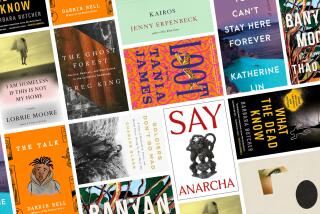Discoveries
- Share via
Pillow Talk in Europe and Other Places
Deborah Levy
Dalkey Archive Press: 125 pp., $12.95 paper
“Our bodies are hesitant and love-soaked. The moon is oily, the trees swollen with black blossoms against the chemical yellow sky. Tonight ... we celebrate living in the metropolis where everything is instant, coffee and pasta, joy and grief, ... and moods swing between violence and tender makings up.” There’s a lot of momentum in these stories, a lot of change, most of it good. The metropolis is London, the characters are anywhere from 20 to 50 and pretty much wrapped up in themselves. In the first, two old friends debate the merits of career vs. family in a funny if brutal way. In the strangest, a young girl decides she’s sick of being a plain-looking socialist and has surgery that turns her into an empty-headed Barbie. Her brother falls in love with her instantly. In the most beautiful, two kids who meet at an orphanage end up marrying. Without excessive language or sentiment, Levy tosses the world at your feet.
*
Odd Girl Speaks Out: Girls Write About Bullies, Cliques, Popularity, and Jealousy
Rachel Simmons
Harvest Books: 208 pp., $13 paper
Rachel SIMMONS’ 1999 book “Odd Girl Out” was about “how our culture affects the way girls show their anger.” It provoked revelations in schools and on talk shows across the country, and Simmons received hundreds of e-mails and letters from girls who wanted to tell their stories. This new book is her attempt to corral those responses into a gut-wrenching, practical catalog of the damage girls inflict on each other and what they can do about it. She’s concerned with the girls who have no friends, aren’t invited to sleepovers, are picked last on every team and have no boyfriends. She’s motivated by the victims’ pain, but she’s also aware of the pain of the perpetrators and believes they can change. She includes advice on how to use e-mail to communicate hurt (but warns against fighting on the computer) and on how to end friendships gracefully. Also on how to react when a close friend decides she wants to be with more popular girls. It’s all here. And an awful lot of it works for the middle-aged too.
*
The Great Belzoni: The Circus Strongman Who Discovered Egypt’s Ancient Treasures
Stanley Mayes
Tauris Parke: 344 pp., $14.50 paper
Here’s the original tomb raider, larger than life, self-made, born in 1778, dead at 45, in 1823, trying to reach Timbuktu. He was by all accounts a giant of a man, well-shaped and handsome. In his youth he trained and lifted weights until he could work in playhouses as a contortionist or a strongman who could lift some 20 men. The “French Hercules” was widely admired, written about by Dickens and Wordsworth. But Giovanni Belzoni’s secret passion was hydraulics; his life as a showman embarrassed him. On his way to Constantinople, he learned that Egypt was in need of hydraulicists to help with irrigation. Provided with contacts, the former contortionist began a new life as an Egyptologist, proving adept not just at finding buried treasures but also at moving them. He found the temple of Abu Simbel, the tomb of Seti I, the heart of the second pyramid, the lost city of Berenice. The British Museum owes most of its Egyptian collection to him. In Qurna, Luxor, Karnak and Thebes he wore Turkish dress, crawled through tunnels to find sarcophagi and led armies of workers. Reading this biography, compiled by Stanley Mayes using everything from Belzoni’s notebooks to playbills, you feel you’re in a great library, with mahogany shelves, crumbling hieroglyphics and oriental rugs. Mayes captures the thrill of discovery: “For the last half hour they were riding on soft sand. Two of the Pyramids had been before them all the way, their black and silver shapes standing out sharply against the indigo velvet of the night.” Or this: “The walls were covered with feathery incrustations of salt that glittered like hoar-frost in the light of the torches.”
More to Read
Sign up for our Book Club newsletter
Get the latest news, events and more from the Los Angeles Times Book Club, and help us get L.A. reading and talking.
You may occasionally receive promotional content from the Los Angeles Times.










